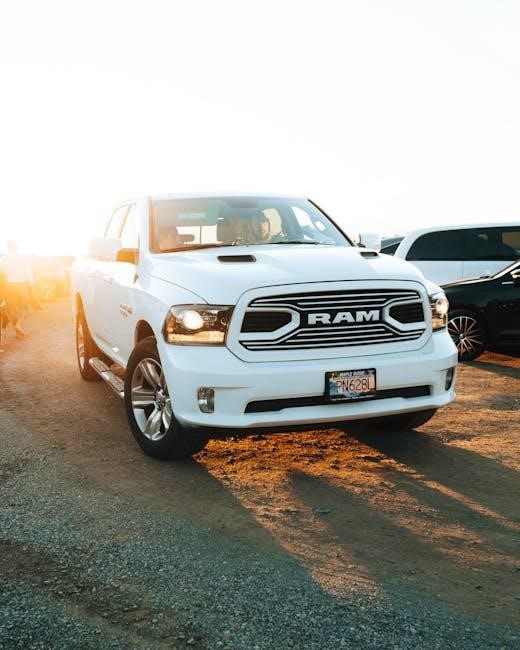Ram Trucks are renowned for their impressive towing capabilities, blending strength and advanced technology. Understanding towing capacity is crucial for safe and efficient hauling, ensuring your truck handles the load effortlessly. Proper equipment and awareness of payload and weight distribution are key to maximizing towing potential while maintaining control and safety on the road.
Understanding Towing Capacity
Towing capacity is the maximum weight a Ram truck can safely tow, determined by its engine power, axle ratio, and overall build. Exceeding this limit can lead to unsafe conditions, including loss of control and increased stopping distances.
Key ratings like GVWR and GCWR help determine towing limits. GVWR is the truck’s maximum allowable weight, including payload, while GCWR includes the combined weight of the truck, trailer, and contents. Ignoring these ratings can result in premature wear on the vehicle’s transmission and engine, and may void warranties.
It’s crucial to use appropriate towing equipment and follow manufacturer guidelines to ensure safe and efficient towing. Always consult the owner’s manual for specific details tailored to your Ram truck model.
Factors Affecting Towing Capacity
Several factors influence the towing capacity of Ram trucks, including engine power, axle ratio, and vehicle configuration. A more powerful engine or lower axle ratio can significantly increase towing ability, while higher payloads reduce available towing capacity due to weight limits.

Gross Vehicle Weight Rating (GVWR) and Gross Combined Weight Rating (GCWR) are critical. GVWR is the maximum weight the truck can carry, including payload, while GCWR includes the truck, trailer, and contents. Exceeding these limits can compromise safety and performance.
Environmental conditions, such as extreme temperatures or hilly terrain, also impact towing capacity. Proper hitch installation and weight distribution are essential to ensure safe and efficient towing, preventing potential damage to the vehicle or loss of control.
Model-Specific Towing Capacities
Ram trucks offer varying towing capacities depending on the model and configuration. The Ram 1500, for instance, can tow up to 12,750 lbs when equipped with the 5.7L V8 HEMI engine. The Ram 2500, powered by the 6.7L Cummins Turbo Diesel, boasts an impressive towing capacity of up to 20,000 lbs, making it ideal for heavy-duty hauling.
The Ram 3500, with its High-Output 6.7L Cummins Turbo Diesel, can tow up to 22,670 lbs, setting a benchmark for superior strength and reliability. Even the Ram 4500, designed for commercial use, offers a towing capacity of up to 25,450 lbs, showcasing Ram’s commitment to delivering powerful towing solutions across its lineup.
Higher trim levels and optional towing packages often enhance these capacities, ensuring users can tailor their truck to meet specific towing needs. Always consult the owner’s manual or Ram’s official towing guide for precise specifications tailored to your vehicle.
How to Calculate Maximum Trailer Weight
To determine the maximum trailer weight your Ram truck can safely tow, start by understanding the Gross Vehicle Weight Rating (GVWR) and Gross Trailer Weight Rating (GTWR). The GVWR is the maximum weight your truck can handle, including payload, passengers, and the truck itself. Subtract the truck’s curb weight from the GVWR to find the available payload capacity, which includes the trailer tongue weight.
A simple formula is: Maximum Trailer Weight = GVWR ⎯ Curb Weight ⎯ Payload. Always refer to your owner’s manual or Ram’s official towing guide for precise specifications. Higher trim levels and optional towing packages often increase these capacities, ensuring your truck meets your towing needs effectively. Using online towing calculators can also provide personalized results for your specific Ram model and configuration.

Payload and Weight Distribution

Payload and Weight Distribution
Payload refers to the total weight your Ram truck can carry, including passengers, cargo, and trailer tongue weight. Proper weight distribution ensures stability and safety while towing, preventing swaying or loss of control. Always adhere to Ram’s specified guidelines to avoid exceeding capacity limits and maintain optimal performance.
Understanding Payload
Payload refers to the total weight your Ram truck can safely carry, including passengers, cargo, and the tongue weight of a trailer. It is calculated by subtracting the truck’s curb weight from its Gross Vehicle Weight Rating (GVWR). Exceeding the payload capacity can compromise safety, handling, and durability. Properly managing payload ensures optimal towing performance and prevents strain on the vehicle’s suspension and braking systems. Always consult your owner’s manual or the manufacturer’s specifications to determine your truck’s payload limits. Additionally, using a tongue weight scale can help you accurately measure and distribute the weight of your trailer, ensuring a safe and stable towing experience. By adhering to these guidelines, you can maximize your Ram truck’s efficiency and reliability while hauling heavy loads.
Proper Weight Distribution
Proper weight distribution is critical for safe and efficient towing with your Ram truck. It ensures stability, prevents swaying, and maintains control while hauling a trailer. The ideal weight distribution typically places 60% of the trailer’s weight on the front axle and 40% on the rear axle. This balance minimizes the risk of trailer sway and enhances braking performance. To achieve proper distribution, use a weight distribution hitch, which transfers some of the trailer’s tongue weight to the front axle. Additionally, ensure the trailer is loaded correctly, with heavier items placed near the front. Always check the manufacturer’s guidelines for recommended weight distribution ratios and adjust your setup accordingly. Proper weight distribution not only improves towing safety but also reduces wear on your truck’s suspension and braking systems, ensuring a smoother and more controlled towing experience.
Impact of Payload on Towing
The payload of your Ram truck significantly impacts its towing performance. Payload refers to the total weight of passengers, cargo, and trailer tongue weight inside the vehicle. Exceeding the recommended payload capacity can reduce your truck’s towing ability, as the vehicle’s resources are divided between carrying and pulling. Always ensure the combined weight of passengers and cargo does not exceed the Gross Vehicle Weight Rating (GVWR). Overloading can lead to reduced braking efficiency, increased stopping distances, and potential damage to the truck’s suspension and engine. For optimal towing, calculate your truck’s payload capacity by subtracting the curb weight from the GVWR. Maintaining the correct balance between payload and towing capacity ensures safe and efficient hauling. Always refer to your owner’s manual for specific weight limits and guidelines for your Ram truck model.

Essential Towing Equipment
Proper towing equipment is vital for safe and efficient hauling. This includes a compatible hitch, wiring harness, and trailer brakes. Tire pressure adjustments and weight distribution systems also play a critical role in towing stability and control.
Types of Hitches
When it comes to towing with a Ram truck, selecting the right hitch is essential for safety and efficiency. The most common types of hitches include Class III and Class IV receiver hitches, which are designed to handle heavy loads. Class III hitches typically offer a towing capacity of up to 8,000 lbs, making them ideal for smaller trailers and boats. Class IV hitches, on the other hand, can handle up to 12,000 lbs, catering to larger trailers and heavier payloads. Additionally, fifth-wheel and gooseneck hitches are available for maximum towing capacity, often exceeding 15,000 lbs, and are preferred for heavy-duty applications like RVs or livestock trailers. Each hitch type is engineered to meet specific towing needs, ensuring compatibility with your Ram truck and the trailer you’re towing.
Wiring Harness and Connectors
A reliable wiring harness and connectors are vital for safe and efficient towing with your Ram truck. The wiring harness connects the truck’s electrical system to the trailer, ensuring proper function of lights, brakes, and other essential systems. Ram trucks often come equipped with a factory-installed wiring harness designed specifically for towing, featuring a plug-and-play connector for convenience. The most common connectors include the 4-pin and 7-pin designs, with the 7-pin offering additional functionality for advanced trailer systems. Using the correct wiring harness and connectors ensures compatibility and prevents electrical issues. It’s crucial to use high-quality, weatherproof connectors to maintain reliability in all conditions. Always refer to your Ram truck’s towing guide or consult a professional if unsure about the right setup for your specific towing needs. Proper installation ensures safety and avoids potential hazards while towing.
Tire Pressure for Towing
Maintaining the correct tire pressure is essential for safe and efficient towing with your Ram truck. Properly inflated tires ensure better traction, reduce the risk of blowouts, and improve fuel efficiency. Always consult your owner’s manual or the tire information placard on the driver’s side doorjamb or inside the fuel filler door for the recommended tire pressure specifications. Tire pressure needs to be adjusted based on the load and driving conditions, especially when towing. Under-inflated tires can lead to increased heat buildup and potential failure, particularly under heavy loads. Modern Ram trucks often feature Tire Pressure Monitoring Systems (TPMS) that alert you to low tire pressure, enhancing safety and convenience. For accurate readings, check tire pressure when the tires are cold (vehicle has not been driven for at least three hours). Adhering to these guidelines ensures safe and efficient towing, protecting both your truck and trailer while promoting tire longevity.